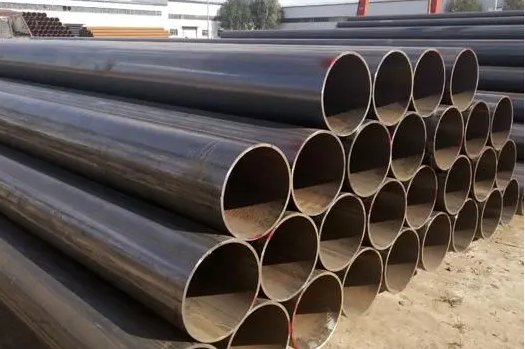ERW pipe refers to electric resistance welded pipe, referred to as ERW, which is used to transport steam and liquid objects such as oil and natural gas. It can meet various requirements of high and low pressure and currently occupies an important position in the field of world pipeline transportation. Resistance welding has the characteristics of high production efficiency, low cost, material saving, and easy automation. Therefore, it is widely used in various industrial sectors such as aviation, aerospace, energy, electronics, automobiles, and light industry, and is one of the important welding processes.
Seamless pipe (SMLS) is a steel pipe made by perforating a whole round steel with no weld on the surface. Seamless steel pipe has a hollow cross-section and is widely used as a pipeline for conveying fluids, such as pipelines for conveying oil, natural gas, coal gas, water and certain solid materials.

What is the Difference between ERW Pipe and Seamless Pipe?
1. Different production processes
ERW pipe refers to a steel strip or steel plate that is bent and deformed into a circle and then welded into a steel pipe with a weld on the surface. High-frequency welding is the core process. The magnetic field generated by high-frequency current causes the edge contact point of the steel pipe forming coil to be locally heated and quickly melted to form a weld. The bond formed in this welding process does not require the use of welding filler materials. To achieve the highest quality welds, the high-frequency ERW process is considered the most commercially viable option.
Unlike
welded steel pipes, the process of manufacturing seamless pipes is longer and more intensive. The process uses hot rolling and several other operations to obtain the final product. The raw steel is first heated and cast into solid billets. These solid billets mold the original steel alloy into a cylindrical shape. After achieving the cylindrical shape, the raw steel pipe is rolled until a stretched and hollow product is formed. The center of this newly manufactured product is irregularly shaped. In order to obtain a more uniform surface and a more uniformly shaped depression, the tip of a bullet-shaped perforator is driven into the center of the billet while rolling the billet. Seamless pipes are steel pipes that are perforated from a whole round steel and have no welds on the surface. Because there are no welds, seamless pipes have excellent compressive resistance and are often used in high temperature and high pressure environments.
2. Different quality requirements
Seamless steel pipes have high quality requirements and must be free of internal defects, smooth in appearance, and free of burrs. However, due to the limitations of production methods, defects such as cracks and pores in the welding parts of ERW welded steel pipes are difficult to avoid. High-quality seamless steel pipes have high raw material and precision processing costs, and the price is correspondingly higher.
3. Different prices
Seamless pipes are more expensive than ERW pipes and have better quality. The price of seamless steel pipes of the same specification is generally about 30% higher than that of welded pipes, and the price difference is greater for large diameters. The stress required for seamless steel pipes can be much higher, and welded steel pipes are generally around 15-20Mpa, so seamless steel pipes are more expensive.
4. Difference cost
Since the manufacturing process of seamless pipes is longer and has more steps, the cost of seamless pipes is always higher than that of welded pipes. ERW pipes are made of cold-bent sheets and then connected together by high-frequency welding, which is a relatively simple process and costs only a fraction of that of seamless pipes.
5. Different application ranges
ERW pipes: ERW straight seam welded pipes are mainly used in water supply projects, petrochemicals, chemical industries, power industries, automobile industries, agricultural irrigation, urban construction, etc.
For liquid transportation: water supply, drainage.
For gas transportation: pipeline systems such as coal gas, steam, liquefied petroleum gas, heating, and air conditioning.
For structural use: pile pipes, bridge pipes, high-rise buildings, large factories and other building structures, as load-bearing and supporting structures; docks, roads, building structures.
Seamless pipes: General-purpose seamless steel pipes are rolled from ordinary carbon structural steel, low-alloy structural steel or alloy structural steel, with the largest output, mainly used as pipelines for conveying fluids or manufacturing structural parts, mechanical parts, such as oil drill bits, etc. Rods, automobile transmission shafts, bicycle racks, steel scaffolding, etc. used in construction are all made of steel pipes into ring-shaped parts, which can improve material utilization, simplify manufacturing processes, and save materials and processing time.
6. Market demand
Seamless steel pipes are widely used in the fields of petroleum, chemical industry, machinery, rail transportation, etc. Due to the particularity of use and quantity requirements, the price of seamless steel pipes is relatively high. Affected by market competition and market demand, the price of ERW steel pipes is relatively low.
In general, seamless steel pipes are more expensive than ERW welded steel pipes. Because the production process and quality requirements of seamless steel pipes are higher, and the market demand is more specialized. But this does not mean that ERW steel pipes are cheaper in all cases, and it needs to be considered comprehensively according to the specific situation.
Extended information:
Why use seamless pipes instead of ERW pipes?
There are two benefits to using seamless pipes. First, the working pressure capacity of seamless pipes is 20% higher than that of ERW pipes, because unlike ERW pipes, applying higher pressures will not cause pipe failure or rupture. Another more popular reason for choosing seamless pipes is that they are not susceptible to intergranular corrosion. Compared with seamless pipes, the seam lines on welded pipes, especially the HAZ or heat-affected weld zone, are affected at the grain boundaries due to sensitization. This intensifies intergranular corrosion, thereby weakening the ERW pipe.
Read more: Schedule 80 carbon steel pipe or Seamless vs. Welded Tubing


